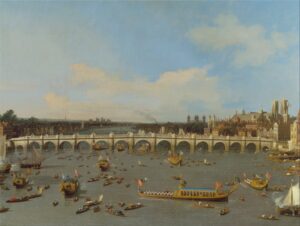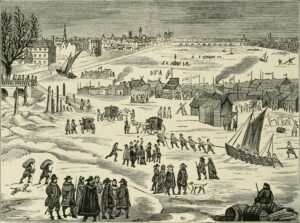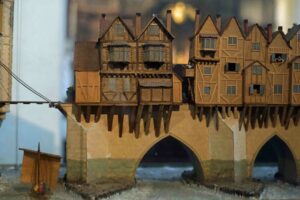Have you ever wondered why London, one of the greatest cities on earth, is situated here? Well, the answer is – the Thames. The history of the river Thames is the history of London and for almost two thousand years, since the founding of the city here by the Romans, it has brought power, prestige, plague and pestilence to its citizens. It has inspired countless poets, painters and authors. Sir Walter Raleigh, the sixteenth century explorer and courtier at the court of Queen Elizabeth I wrote the following: ‘There are two things scarce matched in the universe, the sun in heaven and the Thames on earth’.
These days it is hard to imagine the huge numbers of ships and boats that used the river as a highway and the numerous warehouses that lined the river, many of them now converted into offices and apartments. A boat trip along the Thames is a great way to see London and the history of the river Thames, and a cheap way to do this is to take one of the ferries that run from Woolwich to Hampton Court.
For centuries the river was the city’s main highway and the scene of elaborate royal processions, and for many years the Lord Mayor’s Show also, which took place on the Thames until the 19th century. Our use of the word ‘float’ to describe decorated lorries in carnival processions comes from those days.

The Lord Mayor’s Show still takes place every year on the first Saturday in November where you can see land-bound floats from businesses and livery companies based in the City and schools, military regiments and marching bands parade through the streets to celebrate the new Lord Mayor.
During the hard winters, between the early 17th and 19th centuries – a period known as “the little ice age” – the Thames froze. Londoners, always looking for a way to make money, would set up stalls, side shows and games on the frozen river, including gingerbread stalls, ox-roasting, music booths and even printing presses.

Not everyone enjoyed the Frost Fairs unfortunately, and fishermen and watermen (who made their living ferrying people across the Thames on small boats) walked through the streets of London begging for charity as they could not ply their trade. At least five Frost Fairs took place during this period and the last of these Frost Fairs took place in 1814, and astonishingly an elephant was paraded over the ice!
For centuries the most striking building on the Thames was London Bridge. Commissioned in 1176 by King Henry ll, it was the first stone bridge over the river, and this amazing structure – home to houses, shops and a gatehouse – lasted until the early 19th century. In the centre of the bridge was a chapel dedicated to St Thomas Becket, and the starting point for pilgrims walking to Canterbury to visit his shrine. There is a marvellous model of old LondonBridge in the church of St.Magnus the Martyr, which stands near the current London Bridge.

The Thames is indeed the liquid history of the City of London and continues to offer up buildings, artefacts and stories that give us a fascinating glimpse into the lives of generations of Londoners.
Join Kelly Coburn on A River‘s Tale to learn more about this great river’s history.
